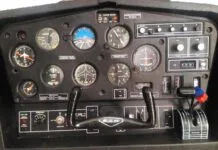Unable VFR On Top
Joe Shelton’s “On Top of the World” article in August and the letters about it since have all missed one important point. VFR on Top is just another altitude assignment while on an IFR flight plan. Like any altitude assignment, ATC may or may not grant it to you.
I’ve usually been denied VFR on Top while trying to escape what I thought were onerous restrictions in busy airspace. Sometimes they’ll give it to me, and that usually seems to work out well for both of us, but the usual response is to get a hard altitude assignment.
I’ve had such refusals near Chicago, New York and Philadelphia. My guess is that in these areas, particularly working traffic like me that cruise in the flight levels, the controllers have a fixed way of doing it and VFR on Top just doesn’t fit into the mold.
Ian Blair Fries, M. D.
Vero Beach, Florida
Got the Time?
In October, “What You Really Need,” Fred Simonds pointed out that the IFR-required clock needs to be built into the panel. I didn’t know that and have always relied on my wristwatch.
Does the timer on my transponder qualify?
Dale C. Eisenman
Hilton Head Island, South Carolina
Interesting point, Dale. In the regulations, section 91.206(d)(6) requires: A clock displaying hours, minutes, and seconds with a sweep-second pointer or digital presentation.
The popular interpretation is that the aircraft, not the pilot, needs to be so equipped.
Also, the popular interpretation seems to be that the clock need not be a separate instrument, but can be a function within something else. Thus, the page in a GNS430, for example, does qualify.
If your transponder timer includes an actual time of day function, then it would qualify as well. However, it sounds as if you’re referring only to a timer, which would not meet the requirement.
It might also be useful to point out that, while we’ll use a timer far more than a clock, we only need that clock, not a timer. In fact, these are only equipment requirements. You’re free to use your wristwatch as long as your aircraft has the required installed equipment.
Timely Question
In the Killer Quiz from the July issue, your answers to questions 5 and 6 suggest that even while on the glidepath I must worry about step down fix crossing altitudes. I thought once I am on the glidepath, I can ignore the crossing altitudes, can’t I?
Ken Karas
Santa Ynez, California
The quick answer, Ken, is that you must comply with crossing restrictions outside the final approach fix, even if you intercepted the glidepath early. Once you’re on the glidepath inside the FAF, though, any crossing restrictions are for a different version of that approach (LOC vs. ILS, for instance) and can be safely ignored.
For the full answer, see Lee Smith’s IFR Clinic, “Watch Your Step(down).”
Better Leave It On
In September’s quiz, your answer to number 7, is incomplete. The FAA now says we should leave our transponders in altitude reporting mode, even on the ground. Here’s the relatively recent change to the AIM:
4-1-20 a.3. Civil and military transponders should be turned to the “on” or normal altitude reporting position prior to moving on the airport surface to ensure the aircraft is visible to ATC surveillance systems.
Keep up the great work.
Jim McIrvin
Graham, Texas
I’m afraid that in the quiz in the September, 2013 issue, you gave a dated answer. The AIM now tells you to leave your transponder on while on the ground and the aircraft is moving.
Unfortunately, that doesn’t address mode S transponders with their automatic ground mode. From what I can tell, this isn’t quite standby—it seems as if mode S will still respond to ASDE-X ground radar systems. I can’t tell if this is absolutely correct, and if the mode S response is sufficient for ASDE-X, Perhaps I should keep my transponder from going into ground mode?
Joe Fournier
Auburn, Maine,
Thanks to the many readers who pointed out that we really need to get an updated copy of the AIM…and read it.
We dug into reader Fournier’s interesting question about mode S on the ground.
Using Garmin’s GTX330 transponder as our model, we confirmed that if installed to do so, “ground” mode is automatic. In this mode, the transponder will still reply in mode S. ASDE-X ground-radar interrogations should be sufficient to trigger that reply, and that reply should satisfy the ASDE-X system.
How Advisory?
Lee Smith’s “Advisory Glidepaths” in June, 2013 was a great article. Some questions about the relationship between the VDA and the FMS’s generated electronic glidepath have come up in the class I’m teaching.
From the article, my understanding is that the database contains the VDA the FMS uses to derive the glidepath. However, if one is not in the source data, does it generate its own VDA for the purpose of calculating an FMS electronic glidepath?
If the approach doesn’t have an electronic advisory glidepath for whatever reason, can operators/pilots use the VDA to calculate their own rate of descent (pseudo) glidepath?
Does an RNAV(GPS) approach with LNAV/VNAV minimums guarantee obstacle clearance below the DA to the runway? Is an LNAN/VNAV approach protected through the GQS?
LCDR Jeff R. Frye, USCG
USCG Aviation Training Center
Mobile, Alabama
FAA data will contain a VDA, an indication that the VDA is not to be used (because of obstructions), or no VDA information at all. In the last case, Jeppesen will calculate and supply the VDA based on crossing restrictions and the threshold crossing height.
The box has no idea if the VDA came from the FAA or from Jepp. It just uses that data to generate the electronic glidepath. If the data says that the VDA is not to be used, such as in approaches the FAA is starting to annotate, “Descent Angle NA” the box will not display a glidepath and you shouldn’t follow a manually created one because the data is missing from the box for safety concerns.
If your system is such that you know there are cases where the data does not contain the “do not use” restriction, but the box still won’t display an advisory glidepath, with caution you may create and follow your own.
For a given approach, there will be only one glidepath (advisory or actual), and it’s based on the published VDA and TCH. Any approach with a published DA rather than MDA (such as LNAV/VNAV, LPV, or ILS) guarantees obstacle clearance below the DA to the runway through the GQS. The GQS is fairly narrow and extends from the DA point to the runway. Since it’s narrower than the visual areas that we talk about in the article, there are cases where the visual area is penetrated by obstacles (near the edges of the visual area, for example), but the GQS is clear.
We try to answer most e-mail, but it often takes a month or more. Please include your name and location. Contact us at [email protected].





